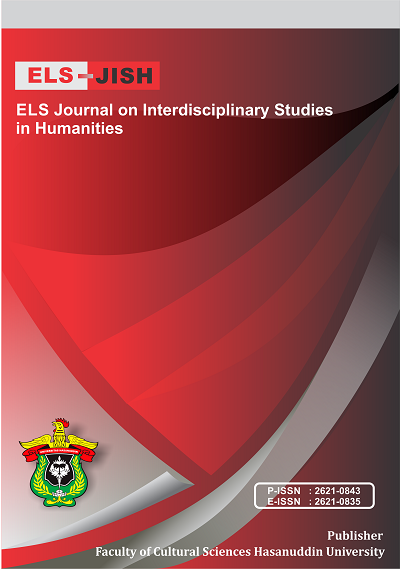The Ability of 1st Class Students of SMAN 11 Enrekang to Arrange Verbal and Nominal Sentences
DOI:
https://doi.org/10.34050/elsjish.v5i3.23171Keywords:
Ability, Simple Present, Surface Strategy Taxonomy, Verbal, NominalAbstract
This research aims to reveal the ability of 1st graders of SMAN 11 Enrekang in compiling verbal and nominal sentences using the simple present tense and the difficulties that occur when compiling verbal and nominal sentences using the simple present tense. The researcher used quantitative method by applying the Surface Strategy Taxonomy in analyzing the data. The results of this research indicating that there are four types of errors. The frequency and percentage based on the surface strategy taxonomy are 63.59% misformation, then 16.18% addition, 13.88% omission, and 6.35% misordering. Furthermore, there are three difficulties experienced by students in compiling verbal and nominal sentences using the simple present tense, 1) Students do not understand the grammatical system; 2) students just write down what comes to mind without following the grammar; and 3) students do not understand vocabulary. The teachers recommend practicing grammar rules, in the simple present tense for mistakes. In addition, other researchers can provide techniques to improve students' mastery of the simple present tense
References
Andini, C. (2021). The Use of Honorifics in English and Buginese with Special Reference to Bone Language: A Comparative Study. International Journal of Innovative Science and Research Technology, 6(7), 873-877.
Apsari, Y. (2018). Snowball Throwing in Teaching Grammar. Lingual, 10(1), 52-59.
Ardiani, A., & Fauziati, E. (2016). An Error Analysis on Writing Recount Text Made by the Eighth Grade Students of SMPN 3 Sawit Boyolali in 2015/2016 Academic Year (Doctoral dissertation, Universitas Muhammadiyah Surakarta).
Ellis, R., & Barkhuizen, G.P. (2005). Analysing Oxford University Learner Language. Press.
Cam, L., & Tran, T. M. T. (2017). An Evaluation of Using Games in Teaching English Grammar for First Year English-Majored Students at Dong Nai Technology University. International Journal of learning, Teaching and Educational Research, 16(7), 55-71.
Coffin, C., Hewings, A., & O'Halloran, K. (2014). Applying English Grammar: Corpus and Functional Approaches. Routledge. Pp. 336
Gusparia, G., & Sabri, M. (2021). An Analysis on The Second Semester Students’ Ability in Understanding Past Simple Sentences at The English Education Department of STKIP Insan Madani Airmolek. Inovish Journal, 6(2), 131-143.
Hewings, A., & Hewings, M. (2005). Grammar and context: an Advanced Resource Book. Psychology Press.
Hendri, N. F. (2018). Improving Students’vocabulary Achievement Through Narrative Text For Second Grade of Senior High School Muhammadiyah Kalosi (Doctoral Dissertation, State Islamic University).
Harmer, J. (2001). The Practice of English Language Teaching London: Longman ELT.
Hornby, A. S. (1989). Oxford Advanced Learner's Dictionary of Current English. Oxford: Oxford University Press.
James, C. (2013). Errors in Learning and Use: Exploring Error Analysis. Routledge
Muhsin, M. A. (2016). Analysing the Students Errors in Using Simple Present (A Case Study at Junior High School in Makassar). Pacific Science Review B: Humanities and Social Sciences, 2(3), 81-87.
Muis, I. A. (2019). An Error Analysis of Using Present Tense by the Tenth Grade Students of Senior High School in Writing Descriptitive Text at MAN 2 Model Medan (Doctoral dissertation, Universitas Islam Negeri Sumatera Utara).
Kirn, E., Jack, D., & O'Sullivan, J. K. (2002). Interactions 1: Grammar. McGraw-Hill/Contemporary.
Lestari, P. A., & Nabah, I. (2019). Analisis Penggunaan “Simple Present Tense” dengan Menggunakan Metode Drilling. Buletin Pengembangan Perangkat Pembelajaran, 1(1).
Özkayran, A., & Yilmaz, E. (2020). Analysis of Higher Education Students' Errors in English Writing Tasks. Advances in Language and Literary Studies, 11(2), 48-58.
Rabiah, S. (2018). Language as a Tool for Communication and Cultural Reality Discloser. Social and Behavioral Sciences Communication Arts and Humanities South and Southeast Asian Languages and Societies (7)8, 1-10.
Rahman, F., & Sadik, A. (2018). Improving The Students’ Speaking Ability Through Silent Way Method at Smu Negeri 12 Makassar. Jurnal Ilmu Budaya, 6(2), 303-312.
Ritonga, S. N. A., Nasmilah, N., & Rahman, F. (2020). The Effect of Motivation and Anxiety on Students’ Speaking Performance: a Study at Dayanu Ikhsanuddin University. ELS Journal on Interdisciplinary Studies in Humanities, 3(2), 198-213.
Sargeant, H. (2007). Basic English grammar for English Language Learners Book 2. Saddleback Educational Publishing.
Seaton, A., & Mew, Y. H. (2007). Basic English Grammar-Book 1.
Shit, R. C., Sharma, S., Puthal, D., James, P., Pradhan, B., Van, M, A., & Ranjan, R. (2019). Ubiquitous Localization (UbiLoc): A Survey and Taxonomy on Device Free Localization for Smart World. IEEE Communications Surveys & Tutorials, 21(4), 3532-3564.
Suhono, S. (2016). Surface Strategy Taxonomy on the EFL Students Composition a Study of Error Analysis. Jurnal Iqra':
Sukmawaty, Rahman, F., & Andini, C. (2022). Covid-19 Pandemic and Axiology of Communication: A Study of Linguistic Phenomena. Change, 7(4).
Sukmawaty, S., Andini, C., & Rahman, F. F. (2022). The Shift of Honorifics due to The Promotion As A Government Official: Comparative Study. ELS Journal on Interdisciplinary Studies in Humanities, 5(1), 166-176.
Weda, S., Atmowardoyo, H., Rahman, F., Said, M. M., & Sakti, A. E. F. (2021). Factors Affecting Students’ Willingness to Communicate in EFL Classroom at Higher Institution in Indonesia. International Journal of Instruction, (14)2.
Weda, S., Atmowardoyo, H., Rahman, F., & Sakti, A. E. F. (2021). Linguistic Aspects in Intercultural Communication (IC) Practices at a Higher Education Institution in Indonesia. Eroupean Language Scientific Journal, (14), 2-6.
Downloads
Published
Issue
Section
License
Copyright (c) 2022 Hasnia Hasnia, Citra Andini, M Dalyan Tahir, Hunaeni Hunaeni, Zulfikariandi Zulfikariandi, Muslimin MT

This work is licensed under a Creative Commons Attribution-NonCommercial-ShareAlike 4.0 International License.






